A System Dynamics Model for Dynamic Capability Driven Sustainability Management
Abstract
:1. Introduction
2. Theoretical Background
2.1. Sustainability Management
2.2. Dynamic Capability
2.3. Dynamic Capability Driven Sustainability Management
2.4. System Dynamics
3. Research Setting and Method
3.1. Step 1: Problem Definition
3.2. Step 2: Dynamic Hypothesis
3.3. Step 3: Formulation: Causal Loop Diagram and Stock and Flow Diagram
3.4. Step 4: Testing and Running the Model
4. Overview of the Case Study: Ethiopian Industrial Park Firms
5. Modeling the Perspectives and Variables: SD Model
5.1. Problem Articulation
5.2. Key Variables and Mathematical Equations
5.2.1. Dynamic Capabilities
- Sensing ability: This is an auxiliary variable influenced by other control variables under the firm’s management. The variables that affect these auxiliary variables are striving for an early sense of sustainability issues and crowdsourcing sustainability information. Striving for an early sense of sustainability issues influences the crowdsourcing sustainability information. The early sense for sustainability issues is influenced by another control variable—the buyer’s pressure designed as the average percentile value.
- Seizing ability: This is the second auxiliary variable within the DC framework. A variable that influences the seizing ability here is the sustainability tools implementation and sustainability training. The sustainability training is designed with a range of 0 to 1, where zero implies that sustainability training has not been delivered, and 1 implies that sustainability training has been delivered well. Sustainability training influences the sustainability tool implementation. In addition to that, the sensing capability has an additional impact on seizing ability, and the function is presented as:
- Transforming ability: Two sub-influencing variables are incorporated in this third auxiliary variable. The first is the regular review of sustainability performance, and the second is the continuous improvement of sustainability practices. Further, transforming ability is influenced by the previous factor seizing ability and a feedback influence from the capability accumulation for sustainability management. In this regard, the function is presented as:
- External capabilitiesCollaboration for sustainability initiatives: This is the first control variable within the framework of external capabilities influencing the adoption of international sustainability standards and the long-term engagement of firms with their crucial stakeholder. The value is designed within 0 to 1, from 0 implying no collaboration, and continues to 1 with strong partnerships for sustainability initiatives.Adoption of international sustainability standards: This is the second auxiliary variable, influenced by the firm’s effort towards collaboration for sustainability initiatives and further from buyer’s pressure as a control variable.Long-term engagement with stakeholders: The third auxiliary variable is influenced by the control variable and function of the firm’s collaboration for sustainability initiatives. The more the collaboration of firms with stakeholders for sustainability initiatives, the more their long-term engagement with stakeholders continues.External capabilities = f (collaboration for sustainability initiatives, adoption of international sustainability standards, long term engagement with stakeholders)
5.2.2. Sustainability Measures
- Economic sustainability Factors: The economic factors are influenced in two ways. The first is from economic sub-factors and environmental sustainability factors. The first sub-factors are productivity, meeting customer delivery time, and achieving export goals/increasing product scope. From the external view, the environmental sustainability factors are energy and water management, green promotion and certification, and implementation of waste management practices and tools.
- Social sustainability factors: Social sustainability factors are influenced by social sustainability and economic sustainability factors. Within the social aspects, key influential variables are worker job satisfaction, commitment and motivation, decision-making skills, worker’s industry culture, and physiology.
- Environmental sustainability factors: Environmental sustainability factors comprehend energy and water management, green promotion, certification, and implementation of waste management practices.
5.2.3. Institutional Pressures from the Case Study
5.3. Dynamic Hypothesis
5.4. Mapping: Causal Diagrams and Stock and Flow Maps
5.5. Formulation of a Simulation Model
Initial Parameters Setting
6. Results
6.1. Existing Capability Growth with Initial Base Values
6.2. Experimental Scenario Simulation
6.2.1. Scenario One: Sustainability Training Efforts
6.2.2. Scenario Two: Collaboration for Sustainability Initiatives
6.2.3. Scenario Three: Industry Working Culture
6.2.4. Scenario Four: Implementation of Waste Management Practice
6.2.5. Scenario Five: Unethical Management and Supervision
6.2.6. Scenario Six: Minimum Wage Concerns
7. Summary and Discussion
7.1. Existing Capability Simulation
7.2. Experimental Scenario Simulation
7.2.1. Dynamic Capability
7.2.2. External Capability
7.2.3. Capability Accumulation for Sustainability Management
7.2.4. Capability Gain Rate
7.3. Dynamic Capability Driven SD Model and Implication for Open Innovation
7.4. Managerial and Theoretical Implication of the Study
8. Conclusions
Author Contributions
Funding
Institutional Review Board Statement
Informed Consent Statement
Data Availability Statement
Conflicts of Interest
References
- Hörisch, J.; Johnson, M.P.; Schaltegger, S. Implementation of Sustainability Management and Company Size: A Knowledge-Based View. Bus. Strat. Environ. 2015, 24, 765–779. [Google Scholar] [CrossRef]
- Ajmal, M.M.; Khan, M.; Hussain, M.; Helo, P. Conceptualizing and incorporating social sustainability in the business world. Int. J. Sustain. Dev. World Ecol. 2018, 25, 327–339. [Google Scholar] [CrossRef]
- Sarkis, J.; Meade, L.M.; Presley, A.R. Incorporating sustainability into contractor evaluation and team formation in the built environment. J. Clean. Prod. 2012, 31, 40–53. [Google Scholar] [CrossRef]
- Machado, C.; de Lima, E.P.; da Costa, S.E.G.; Angelis, J.J.; Mattioda, R.A. Framing maturity based on sustainable operations management principles. Int. J. Prod. Econ. 2017, 190, 3–21. [Google Scholar] [CrossRef]
- Kleindorfer, P.R.; Singhal, K.; Van Wassenhove, L.N.V. Sustainable Operations Management. Prod. Oper. Manag. 2005, 14, 482–492. [Google Scholar] [CrossRef]
- Faulkner, W.; Badurdeen, F. Sustainable Value Stream Mapping (Sus-VSM): Methodology to visualize and assess manufacturing sustainability performance. J. Clean. Prod. 2014, 85, 8–18. [Google Scholar] [CrossRef]
- Buzzao, G.; Rizzi, F. On the conceptualization and measurement of dynamic capabilities for sustainability: Building theory through a systematic literature review. Bus. Strat. Environ. 2021, 30, 135–175. [Google Scholar] [CrossRef]
- Köksal, D.; Strähle, J.; Müller, M. Social Sustainability in Apparel Supply Chains—The Role of the Sourcing Intermediary in a Developing Country. Sustainability 2018, 10, 1039. [Google Scholar] [CrossRef] [Green Version]
- Varsei, M.; Soosay, C.; Fahimnia, B.; Sarkis, J. Framing sustainability performance of supply chains with multidimensional indicators. Supply Chain Manag. Int. J. 2014, 19, 242–257. [Google Scholar] [CrossRef]
- Beske, P.; Seuring, S. Putting sustainability into supply chain management. Supply Chain Manag. Int. J. 2014, 19, 322–331. [Google Scholar] [CrossRef]
- Wu, Q.; He, Q.; Duan, Y. Explicating dynamic capabilities for corporate sustainability. EuroMed J. Bus. 2013, 8, 255–272. [Google Scholar] [CrossRef]
- Shang, H.; Chen, R.; Li, Z. Dynamic sustainability capabilities and corporate sustainability performance: The mediating effect of resource management capabilities. Sustain. Dev. 2019, 28, 595–612. [Google Scholar] [CrossRef]
- Bari, N.; Chimhundu, R.; Chan, K.-C. Dynamic Capabilities to Achieve Corporate Sustainability: A Roadmap to Sustained Competitive Advantage. Sustainability 2022, 14, 1531. [Google Scholar] [CrossRef]
- Teece, D.; Pisano, G.; Shuen, A. Dynamic Capabilities and Strategic Management. Strateg. Manag. J. 1997, 18, 509–533. [Google Scholar] [CrossRef]
- Amui, L.B.L.; Jabbour, C.J.C.; de Sousa Jabbour, A.B.L.; Kannan, D. Sustainability as a dynamic organizational capability: A systematic review and a future agenda toward a sustainable transition. J. Clean. Prod. 2017, 142, 308–322. [Google Scholar] [CrossRef]
- Lin, Y.; Wu, L.-Y. Exploring the role of dynamic capabilities in firm performance under the resource-based view framework. J. Bus. Res. 2014, 67, 407–413. [Google Scholar] [CrossRef]
- Gruchmann, T.; Seuring, S.; Petljak, K. Assessing the role of dynamic capabilities in local food distribution: A theory-elaboration study. Supply Chain Manag. Int. J. 2019, 24, 767–783. [Google Scholar] [CrossRef]
- Beske, P.; Land, A.; Seuring, S. Sustainable supply chain management practices and dynamic capabilities in the food industry: A critical analysis of the literature. Int. J. Prod. Econ. 2014, 152, 131–143. [Google Scholar] [CrossRef]
- Rebs, T.; Thiel, D.; Brandenburg, M.; Seuring, S. Impacts of stakeholder influences and dynamic capabilities on the sustainability performance of supply chains: A system dynamics model. J. Bus. Econ. 2019, 89, 893–926. [Google Scholar] [CrossRef]
- Seuring, S. A review of modeling approaches for sustainable supply chain management. Decis. Support Syst. 2013, 54, 1513–1520. [Google Scholar] [CrossRef]
- Delai, I.; Takahashi, S. Sustainability measurement system: A reference model proposal. Soc. Responsib. J. 2011, 7, 438–471. [Google Scholar] [CrossRef]
- Yun, J.J.; Won, D.; Park, K.; Jeong, E.; Zhao, X. The role of a business model in market growth: The difference between the converted industry and the emerging industry. Technol. Forecast. Soc. Chang. 2019, 146, 534–562. [Google Scholar] [CrossRef]
- Sjaifuddin, S. Environmental Management of Industrial Estate Based on Eco-Industrial Parks: A System Dynamics Modeling. Ind. Eng. Manag. Syst. 2020, 19, 211–227. [Google Scholar] [CrossRef]
- Teece, D.J. Dynamic capabilities as (workable) management systems theory. J. Manag. Organ. 2018, 24, 359–368. [Google Scholar] [CrossRef] [Green Version]
- Wiengarten, F.; Ahmed, M.U.; Longoni, A.; Pagell, M.; Fynes, B. Complexity and the triple bottom line: An information-processing perspective. Int. J. Oper. Prod. Manag. 2017, 37, 1142–1163. [Google Scholar] [CrossRef] [Green Version]
- Schaltegger, S.; Beckmann, M.; Hansen, E.G. Transdisciplinarity in Corporate Sustainability: Mapping the Field. Bus. Strat. Environ. 2013, 22, 219–229. [Google Scholar] [CrossRef]
- Barrett, P.M.; Baumann-Pauly, D. Made in Ethiopia: Challenges in the Garment Industry’s New Frontier; Stern: New York, NY, USA, 2019. [Google Scholar]
- Aguado, S.; Alvarez, R.; Domingo, R. Model of efficient and sustainable improvements in a lean production system through processes of environmental innovation. J. Clean. Prod. 2013, 47, 141–148. [Google Scholar] [CrossRef]
- Hallgren, M.; Olhager, J. Lean and agile manufacturing: External and internal drivers and performance outcomes. Int. J. Oper. Prod. Manag. 2009, 29, 976–999. [Google Scholar] [CrossRef] [Green Version]
- Cagno, E.; Neri, A.; Howard, M.; Brenna, G.; Trianni, A. Industrial sustainability performance measurement systems: A novel framework. J. Clean. Prod. 2019, 230, 1354–1375. [Google Scholar] [CrossRef]
- Harik, R.; EL Hachem, W.; Medini, K.; Bernard, A. Towards a holistic sustainability index for measuring sustainability of manufacturing companies. Int. J. Prod. Res. 2014, 53, 4117–4139. [Google Scholar] [CrossRef]
- Sala, S.; Ciuffo, B.; Nijkamp, P. A systemic framework for sustainability assessment. Ecol. Econ. 2015, 119, 314–325. [Google Scholar] [CrossRef]
- Azzone, G.; Noci, G.; Manzini, R.; Welford, R.; Young, C.W. Defining Environmental Performance Indicators: An Integrated Framework. Bus. Strat. Environ. 1996, 5, 69–80. [Google Scholar] [CrossRef]
- Ball, A.; Broadbent, J.; Jarvis, T. Waste management, the challenges of the PFI and “sustainability reporting”. Bus. Strat. Environ. 2006, 15, 258–274. [Google Scholar] [CrossRef]
- Dahmus, J.B. Can Efficiency Improvements Reduce Resource Consumption? J. Ind. Ecol. 2014, 18, 883–897. [Google Scholar] [CrossRef]
- Rusinko, C.A. Green Manufacturing: An Evaluation of Environmentally Sustainable Manufacturing Practices and Their Impact on Competitive Outcomes. IEEE Trans. Eng. Manag. 2007, 54, 445–454. [Google Scholar] [CrossRef]
- Dieste, M.; Panizzolo, R.; Garza-Reyes, J.A.; Anosike, A. The relationship between lean and environmental performance: Practices and measures. J. Clean. Prod. 2019, 224, 120–131. [Google Scholar] [CrossRef]
- Alves, A.; Moreira, F.; Abreu, F.; Colombo, C. Sustainability, Lean and Eco-Efficiency Symbioses; Springer: Berlin/Heidelberg, Germany, 2016; pp. 91–112. [Google Scholar]
- Green, K.; Morton, B.; New, S. Green purchasing and supply policies: Do they improve companies “environmental performance”? Supply Chain Manag. Int. J. 1998, 3, 89–95. [Google Scholar] [CrossRef]
- Rajak, S.; Vinodh, S. Application of fuzzy logic for social sustainability performance evaluation: A case study of an Indian automotive component manufacturing organization. J. Clean. Prod. 2015, 108, 1184–1192. [Google Scholar] [CrossRef]
- Lee, W.-T.; Haapala, K.R.; Edwards, M.E.; Funk, K.H. A Framework for the Evaluation and Redesign of Human Work Based on Societal Factors. In Leveraging Technology for a Sustainable World; Springer: Berlin/Heidelberg, Germany, 2012; pp. 575–580. [Google Scholar]
- Przekop, L.A.; Kerr, S. Life cycle tools for future product sustainability. In Proceedings of the IEEE International Symposium on Electronics and the Environment, Conference Record, Scottsdale, AZ, USA, 10–13 May 2004; pp. 23–26. [Google Scholar]
- Azapagic, A. Developing a framework for sustainable development indicators for the mining and minerals industry. J. Clean. Prod. 2004, 12, 639–662. [Google Scholar] [CrossRef]
- Hunkeler, D.; Rebitzer, G. The Future of Life Cycle Assessment. Int. J. Life Cycle Assess. 2005, 10, 305–308. [Google Scholar] [CrossRef]
- Garbie, I.H. Fundamental requirements for sustainability practices and implementation: An analytical modelling and empirical investigation. Int. J. Sustain. Manuf. 2015, 3, 333. [Google Scholar] [CrossRef]
- Hubbard, G. Measuring organizational performance: Beyond the triple bottom line. Bus. Strat. Environ. 2009, 18, 177–191. [Google Scholar] [CrossRef]
- Amrina, E.; Yusof, S.M. Interpretive structural model of key performance indicators for sustainable manufacturing evaluation in automotive companies. In Proceedings of the 2012 IEEE International Conference on Industrial Engineering and Engineering Management, Hong Kong, China, 10–13 December 2012; pp. 656–660. [Google Scholar]
- Garbie, I.H. An analytical technique to model and assess sustainable development index in manufacturing enterprises. Int. J. Prod. Res. 2013, 52, 4876–4915. [Google Scholar] [CrossRef]
- Govindan, K.; Khodaverdi, R.; Jafarian, A. A fuzzy multi criteria approach for measuring sustainability performance of a supplier based on triple bottom line approach. J. Clean. Prod. 2013, 47, 345–354. [Google Scholar] [CrossRef]
- Jabbour, A.B.L.D.S.; Jabbour, C.J.C.; Govindan, K.; Kannan, D.; Arantes, A.F. Mixed methodology to analyze the relationship between maturity of environmental management and the adoption of green supply chain management in Brazil. Resour. Conserv. Recycl. 2014, 92, 255–267. [Google Scholar] [CrossRef]
- Sarkis, J.; Bai, C.; Jabbour, A.B.L.D.S.; Jabbour, C.J.C.; Sobreiro, V.A. Connecting the pieces of the puzzle toward sustainable organizations. Benchmarking Int. J. 2016, 23, 1605–1623. [Google Scholar] [CrossRef] [Green Version]
- Luthra, S.; Kumar, A.; Zavadskas, E.K.; Mangla, S.K.; Garza-Reyes, J.A. Industry 4.0 as an enabler of sustainability diffusion in supply chain: An analysis of influential strength of drivers in an emerging economy. Int. J. Prod. Res. 2020, 58, 1505–1521. [Google Scholar] [CrossRef]
- Lozano, R.; Carpenter, A.; Huisingh, D. A review of “theories of the firm” and their contributions to Corporate Sustainability. J. Clean. Prod. 2015, 106, 430–442. [Google Scholar] [CrossRef]
- Gunasekaran, A.; Spalanzani, A. Sustainability of manufacturing and services: Investigations for research and applications. Int. J. Prod. Econ. 2012, 140, 35–47. [Google Scholar] [CrossRef]
- Mangla, S.; Madaan, J.; Chan, F.T. Analysis of flexible decision strategies for sustainability-focused green product recovery system. Int. J. Prod. Res. 2013, 51, 3428–3442. [Google Scholar] [CrossRef]
- Garcia-Torres, S.; Albareda, L.; Rey-Garcia, M.; Seuring, S. Traceability for sustainability—Literature review and conceptual framework. Supply Chain Manag. Int. J. 2019, 24, 85–106. [Google Scholar] [CrossRef]
- Seuring, S.; Gold, S. Sustainability management beyond corporate boundaries: From stakeholders to performance. J. Clean. Prod. 2013, 56, 1–6. [Google Scholar] [CrossRef]
- Seuring, S.; Müller, M. From a literature review to a conceptual framework for sustainable supply chain management. J. Clean. Prod. 2008, 16, 1699–1710. [Google Scholar] [CrossRef]
- Brandenburg, M.; Govindan, K.; Sarkis, J.; Seuring, S. Quantitative models for sustainable supply chain management: Developments and directions. Eur. J. Oper. Res. 2014, 233, 299–312. [Google Scholar] [CrossRef]
- Seuring, S.; Sarkis, J.; Müller, M.; Rao, P. Sustainability and supply chain management—An introduction to the special issue. J. Clean. Prod. 2008, 16, 1545–1551. [Google Scholar] [CrossRef]
- Eriksson, D.; Svensson, G. A balance model of theoretical sustainability—Framework and propositions. Corp. Governance: Int. J. Bus. Soc. 2016, 16, 21–34. [Google Scholar] [CrossRef]
- Tseng, M.-L.; Wu, K.-J.; Ma, L.; Kuo, T.C.; Sai, F. A hierarchical framework for assessing corporate sustainability performance using a hybrid fuzzy synthetic method-DEMATEL. Technol. Forecast. Soc. Chang. 2019, 144, 524–533. [Google Scholar] [CrossRef]
- Tseng, M.-L.; Chang, C.-H.; Lin, C.-W.R.; Wu, K.-J.; Chen, Q.; Xia, L.; Xue, B. Future trends and guidance for the triple bottom line and sustainability: A data driven bibliometric analysis. Environ. Sci. Pollut. Res. 2020, 27, 33543–33567. [Google Scholar] [CrossRef]
- Engert, S.; Rauter, R.; Baumgartner, R.J. Exploring the integration of corporate sustainability into strategic management: A literature review. J. Clean. Prod. 2016, 112, 2833–2850. [Google Scholar] [CrossRef]
- De Pádua, S.I.D.; Jabbour, C.J.C. Promotion and evolution of sustainability performance measurement systems from a perspective of business process management. Bus. Process Manag. J. 2015, 21, 403–418. [Google Scholar] [CrossRef]
- Schaltegger, S.; Wagner, M. Integrative management of sustainability performance, measurement and reporting. Int. J. Account. Audit. Perform. Eval. 2006, 3, 1–19. [Google Scholar] [CrossRef]
- Maas, K.; Schaltegger, S.; Crutzen, N. Integrating corporate sustainability assessment, management accounting, control, and reporting. J. Clean. Prod. 2016, 136, 237–248. [Google Scholar] [CrossRef]
- Silva, S.; Nuzum, A.-K.; Schaltegger, S. Stakeholder expectations on sustainability performance measurement and assessment. A systematic literature review. J. Clean. Prod. 2019, 217, 204–215. [Google Scholar] [CrossRef]
- Schaltegger, S.; Burritt, R. Measuring and managing sustainability performance of supply chains. Supply Chain Manag. Int. J. 2014, 19, 232–241. [Google Scholar] [CrossRef]
- Barney, J.B.; Ketchen, D.J.; Wright, M. The Future of Resource-Based Theory. J. Manag. 2011, 37, 1299–1315. [Google Scholar] [CrossRef]
- Barreto, I. Dynamic Capabilities: A Review of Past Research and an Agenda for the Future. J. Manag. 2009, 36, 256–280. [Google Scholar] [CrossRef] [Green Version]
- Bayu, F.G.; Ebinger, F.; Berhan, E. Integrating Sustainability Measures and Practices in the Ethiopian Industrial Parks: From Review to Conceptual Model. In Lecture Notes of the Institute for Computer Sciences, Social Informatics and Telecommunications Engineering; Springer: Berlin/Heidelberg, Germany, 2022; Volume 412, pp. 262–276. [Google Scholar]
- Abernathy, W.J.; Clark, K.B. Innovation: Mapping the winds of creative destruction. Res. Policy 1985, 14, 3–22. [Google Scholar] [CrossRef]
- Singh, A.K.; Burhan, M. Configuring dynamic capability architecture for understanding changes. Int. J. Strat. Chang. Manag. 2018, 7, 109. [Google Scholar] [CrossRef]
- Henderson, R.; Cockburn, I. Measuring Competence? Exploring Firm Effects in Pharmaceutical Research. Strat. Manag. J. 1994, 15, 63–84. [Google Scholar] [CrossRef] [Green Version]
- Sheng, M.L. A dynamic capabilities-based framework of organizational sensemaking through combinative capabilities towards exploratory and exploitative product innovation in turbulent environments. Ind. Mark. Manag. 2017, 65, 28–38. [Google Scholar] [CrossRef]
- Kogut, B.; Zander, U. Knowledge of the Firm, Combinative Capabilities, and the Replication of Technology. Organ. Sci. 1992, 3, 383–397. [Google Scholar] [CrossRef]
- Teece, D.J.; Maritam, C.A. Dynamic Capabilities and Organizational Process; Blackwell: Hoboken, NJ, USA, 2007. [Google Scholar]
- Wójcik, P. Exploring Links Between Dynamic Capabilities Perspective and Resource-Based View: A Literature Overview. Int. J. Manag. Econ. 2015, 45, 83–107. [Google Scholar] [CrossRef] [Green Version]
- Bao-Jie, C. An Empirical Study on Firm Dynamic Capabilities Influencing Innovation Performance. In Proceedings of the 2010 3rd International Conference on Information Management, Innovation Management and Industrial Engineering, Kunming, China, 26–28 November 2010; Volume 2, pp. 651–654. [Google Scholar]
- Eisenhardt, K.M.; Martin, J.A. Dynamic capabilities: What are they? Strateg. Manag. J. 2000, 21, 1105–1121. [Google Scholar] [CrossRef]
- Baía, E.P.; Ferreira, J.J.M. Dynamic capabilities and performance: How has the relationship been assessed? J. Manag. Organ. 2019, 1–30. [Google Scholar] [CrossRef]
- Easterby-Smith, M.; Prieto, I.M. Dynamic Capabilities and Knowledge Management: An Integrative Role for Learning? Br. J. Manag. 2008, 19, 235–249. [Google Scholar] [CrossRef] [Green Version]
- Zollo, M.; Winter, S.G. Deliberate Learning and the Evolution of Dynamic Capabilities. Organ. Sci. 2002, 13, 339–351. [Google Scholar] [CrossRef] [Green Version]
- Bowman, C.; Ambrosini, V. How the Resource-based and the Dynamic Capability Views of the Firm Inform Corporate-level Strategy. Br. J. Manag. 2003, 14, 289–303. [Google Scholar] [CrossRef]
- Buxton, J.; Davidson, M. Building a sustainable growth capability. Strat. Leadersh. 1996, 24, 33–38. [Google Scholar] [CrossRef]
- Pavlou, P.A.; El Sawy, O.A. Understanding the Elusive Black Box of Dynamic Capabilities. Decis. Sci. 2011, 42, 239–273. [Google Scholar] [CrossRef]
- Sarkis, J.; Zhu, Q.; Lai, K.-H. An organizational theoretic review of green supply chain management literature. Int. J. Prod. Econ. 2011, 130, 1–15. [Google Scholar] [CrossRef]
- Di Stefano, G.; Peteraf, M.; Verona, G. Dynamic capabilities deconstructed: A bibliographic investigation into the origins, development, and future directions of the research domain. Ind. Corp. Chang. 2010, 19, 1187–1204. [Google Scholar] [CrossRef] [Green Version]
- Cezarino, L.; Alves, M.F.R.; Caldana, A.C.F.; Liboni, L.B. Dynamic Capabilities for Sustainability: Revealing the Systemic Key Factors. Syst. Pract. 2019, 32, 93–112. [Google Scholar] [CrossRef]
- Arend, R.J. Social and Environmental Performance at SMEs: Considering Motivations, Capabilities, and Instrumentalism. J. Bus. Ethic 2013, 125, 541–561. [Google Scholar] [CrossRef]
- Chen, Y.-S.; Chang, C.-H. The Determinants of Green Product Development Performance: Green Dynamic Capabilities, Green Transformational Leadership, and Green Creativity. J. Bus. Ethic 2013, 116, 107–119. [Google Scholar] [CrossRef]
- Drnevich, P.L.; Kriauciunas, A.P. Clarifying the conditions and limits of the contributions of ordinary and dynamic capabilities to relative firm performance. Strat. Manag. J. 2011, 32, 254–279. [Google Scholar] [CrossRef]
- Protogerou, A.; Caloghirou, Y.; Lioukas, S. Dynamic capabilities and their indirect impact on firm performance. Ind. Corp. Chang. 2012, 21, 615–647. [Google Scholar] [CrossRef]
- Wu, Q.; He, Q.; Duan, Y.; O’Regan, N. Implementing dynamic capabilities for corporate strategic change toward sustainability. Strat. Chang. 2012, 21, 231–247. [Google Scholar] [CrossRef]
- Da Giau, A.; Foss, N.J.; Furlan, A.; Vinelli, A. Sustainable development and dynamic capabilities in the fashion industry: A multi-case study. Corp. Soc. Responsib. Environ. Manag. 2020, 27, 1509–1520. [Google Scholar] [CrossRef]
- Choi, S.-B.; Feng, Y.; Liu, J.; Zhu, Q. Motivating corporate social responsibility practices under customer pressure among small- and medium-sized suppliers in China: The role of dynamic capabilities. Corp. Soc. Responsib. Environ. Manag. 2019, 26, 213–226. [Google Scholar] [CrossRef] [Green Version]
- Wang, C.L.; Senaratne, C.; Rafiq, M. Success Traps, Dynamic Capabilities and Firm Performance. Br. J. Manag. 2014, 26, 26–44. [Google Scholar] [CrossRef]
- Rehman, K.U.; Saeed, Z. Impact of Dynamic Capabilities on Firm Performance: Moderating Role of Organizational Competencies. Sukkur IBA J. Manag. Bus. 2015, 2, 20–42. [Google Scholar] [CrossRef] [Green Version]
- Dangelico, R.M.; Pujari, D.; Pontrandolfo, P. Green product innovation in manufacturing firms: A sustainability-oriented dynamic capability perspective. Bus. Strategy Environ. 2017, 26, 490–506. [Google Scholar] [CrossRef]
- Mousavi, S.; Bossink, B.; van Vliet, M. Dynamic capabilities and organizational routines for managing innovation towards sustainability. J. Clean. Prod. 2018, 203, 224–239. [Google Scholar] [CrossRef]
- Vanpoucke, E.; Vereecke, A.; Wetzels, M. Developing supplier integration capabilities for sustainable competitive advantage: A dynamic capabilities approach. J. Oper. Manag. 2014, 32, 446–461. [Google Scholar] [CrossRef]
- Bleady, A.; Ali, A.H.; Balal, S. Towards an integrative model of dynamic capabilities empirical research: A systematic review (1997–2015). Int. J. Bus. Excel. 2019, 18, 203. [Google Scholar] [CrossRef]
- Adeniran, T.V. Investigating the dynamic capabilities and competitive advantage of South African SMEs. Afr. J. Bus. Manag. 2012, 6, 4088–4099. [Google Scholar] [CrossRef]
- Nyachanchu, T.O.; Chepkwony, J.; Bonuke, R. Role of Dynamic Capabilities in the Performance of Manufacturing Firms in Nairobi County, Kenya. Eur. Sci. J. ESJ 2017, 13, 438. [Google Scholar] [CrossRef] [Green Version]
- Kitenga, G.; Kilika, J.M.; Muchemi, A.W. The Moderating effect of Firm Size on the impact of Dynamic Capabilities on sustainable Performance of food manufacturing firms Kenya. Tech. Soc. Sci. J. 2020, 7, 149–182. [Google Scholar] [CrossRef]
- Akhtar, P.; Ullah, S.; Amin, S.H.; Kabra, G.; Shaw, S. Dynamic capabilities and environmental sustainability for emerging economies’ multinational enterprises. Int. Stud. Manag. Organ. 2020, 50, 27–42. [Google Scholar] [CrossRef]
- Eikelenboom, M.; de Jong, G. The impact of dynamic capabilities on the sustainability performance of SMEs. J. Clean. Prod. 2019, 235, 1360–1370. [Google Scholar] [CrossRef]
- Siems, E.; Land, A.; Seuring, S. Dynamic capabilities in sustainable supply chain management: An inter-temporal comparison of the food and automotive industries. Int. J. Prod. Econ. 2021, 236, 108128. [Google Scholar] [CrossRef]
- Beske, P. Dynamic capabilities and sustainable supply chain management. Int. J. Phys. Distrib. Logist. Manag. 2012, 42, 372–387. [Google Scholar] [CrossRef]
- Wu, Q.; He, Q.; Duan, Y. Dynamic capabilities for CSR management: Towards identifying common processes. Soc. Bus. Rev. 2014, 9, 276–297. [Google Scholar] [CrossRef] [Green Version]
- Schulz, S.A.; Flanigan, R.L. Developing competitive advantage using the triple bottom line: A conceptual framework. J. Bus. Ind. Mark. 2016, 31, 449–458. [Google Scholar] [CrossRef]
- Svensson, G.; Ferro, C.; Høgevold, N.; Padin, C.; Varela, J.C.S.; Sarstedt, M. Framing the triple bottom line approach: Direct and mediation effects between economic, social and environmental elements. J. Clean. Prod. 2018, 197, 972–991. [Google Scholar] [CrossRef]
- Garbie, I. Investigation of Sustainability index in Omani manufacturing firms: Evidence from industrial company. In Proceedings of the 2015 International Conference on Industrial Engineering and Operations Management (IEOM), Dubai, United Arab Emirates, 3–5 March 2015; pp. 1–7. [Google Scholar] [CrossRef]
- Ocampo, L.A.; Clark, E.E.; Promentilla, M.A.B. Computing sustainable manufacturing index with fuzzy analytic hierarchy process. Int. J. Sustain. Eng. 2016, 9, 305–314. [Google Scholar] [CrossRef]
- Trianni, A.; Cagno, E.; Neri, A.; Howard, M. Measuring industrial sustainability performance: Empirical evidence from Italian and German manufacturing small and medium enterprises. J. Clean. Prod. 2019, 229, 1355–1376. [Google Scholar] [CrossRef]
- Gomes, C.M.; Kneipp, J.M.; Kruglianskas, I.; da Rosa, L.A.B.; Bichueti, R.S. Management for sustainability: An analysis of the key practices according to the business size. Ecol. Indic. 2015, 52, 116–127. [Google Scholar] [CrossRef]
- Arena, M.; Ciceri, N.D.; Terzi, S.; Bengo, I.; Azzone, G.; Garetti, M. A state-of-the-art of industrial sustainability: Definitions, tools and metrics. Int. J. Prod. Lifecycle Manag. 2009, 4, 207. [Google Scholar] [CrossRef]
- Garbie, I. Sustainability in Manufacturing Enterprises: Concepts, Analyses and Assessments for Industry; Springer: Berlin/Heidelberg, Germany, 2016. [Google Scholar]
- Vencato, C.H.D.R.; Gomes, C.; Scherer, F.; Kneipp, J.M.; Bichueti, R.S. Strategic sustainability management and export performance. Manag. Environ. Qual. Int. J. 2014, 25, 431–445. [Google Scholar] [CrossRef]
- Essid, M.; Berland, N. Adoption of environmental management tools: The dynamic capabilities contributions. Sustain. Account. Manag. Policy J. 2018, 9, 229–252. [Google Scholar] [CrossRef]
- Panda, S.S.; Sangle, S. Stakeholder engagement as a dynamic capability. Bus. Strat. Dev. 2019, 3, 204–212. [Google Scholar] [CrossRef]
- Cosenz, F.; Noto, L. Combining system dynamics modelling and management control systems to support strategic learning processes in SMEs: A Dynamic Performance Management approach. J. Manag. Control 2015, 26, 225–248. [Google Scholar] [CrossRef]
- Lane, D.C. The power of the bond between cause and effect: Jay Wright Forrester and the field of system dynamics. Syst. Dyn. Rev. 2007, 23, 95–118. [Google Scholar] [CrossRef]
- Bianchi, C. Dynamic Performance Management; Springer: Berlin/Heidelberg, Germany, 2016. [Google Scholar]
- Sterman, J.D. Sterman-Business Dynamics—3.pdf; Jeffrey J. Shelsfud Senior MIT: Cambridge, MA, USA, 2000. [Google Scholar]
- Childe, S.J. Case studies in operations management. Prod. Plan. Control 2011, 22, 107. [Google Scholar] [CrossRef]
- Robson, K.; McCartan, C. Real World Research; John Wiley & Sons Ltd.: Hoboken, NJ, USA, 2016. [Google Scholar]
- Yin, R. Case Study Research: Design and Methods. 2009. Available online: https://us.sagepub.com/en-us/nam/case-study-research-and-applications/book250150 (accessed on 13 February 2022).
- Bala, B.K.; Arshad, F.M.; Noh, K.M. System Dynamics. In Modelling and Simulation; Springer: Berlin/Heidelberg, Germany, 2017. [Google Scholar]
- Mousavi, A.; Mohammadzadeh, M.; Zare, H. Developing a System Dynamic Model for Product Life Cycle Management of Generic Pharmaceutical Products: Its Relation with Open Innovation. J. Open Innov. Technol. Mark. Complex. 2022, 8, 14. [Google Scholar] [CrossRef]
- Hamel, C.K.P.G. Prahalad and Hamel_1990_the Core Competence of the Corporation.pdf. 1990. Available online: https://hbr.org/1990/05/the-core-competence-of-the-corporation (accessed on 13 February 2022).
- Duggan, J. System Dynamics Modeling with R: Lecture Notes in Social Networks. 2016. Available online: https://link.springer.com/book/10.1007/978-3-319-34043-2 (accessed on 13 February 2022).
- Bianchi, C. Enhancing Performance Management and Sustainable Organizational Growth through System-Dynamics Modelling. In Systemic Management for Intelligent Organizations; Springer: Berlin/Heidelberg, Germany, 2012; pp. 143–161. [Google Scholar]
- Sosnovskikh, S. Industrial clusters in Russia: The development of special economic zones and industrial parks. Russ. J. Econ. 2017, 3, 174–199. [Google Scholar] [CrossRef]
- Negarit, G. Industrial Park Proclamation 886/2015; Federal Negarit Gazette: Addis Abeba, Ethiopia, 2015; Volume 39.
- Lemma, S.; Girma, S. Employee Turnover Challenges at Hawassa; Fortune: Addis Abeba, Ethiopia, 2019. [Google Scholar]
- Lee, K.; Yoo, J. How does open innovation lead competitive advantage? A dynamic capability view perspective. PLoS ONE 2019, 14, e0223405. [Google Scholar] [CrossRef] [Green Version]

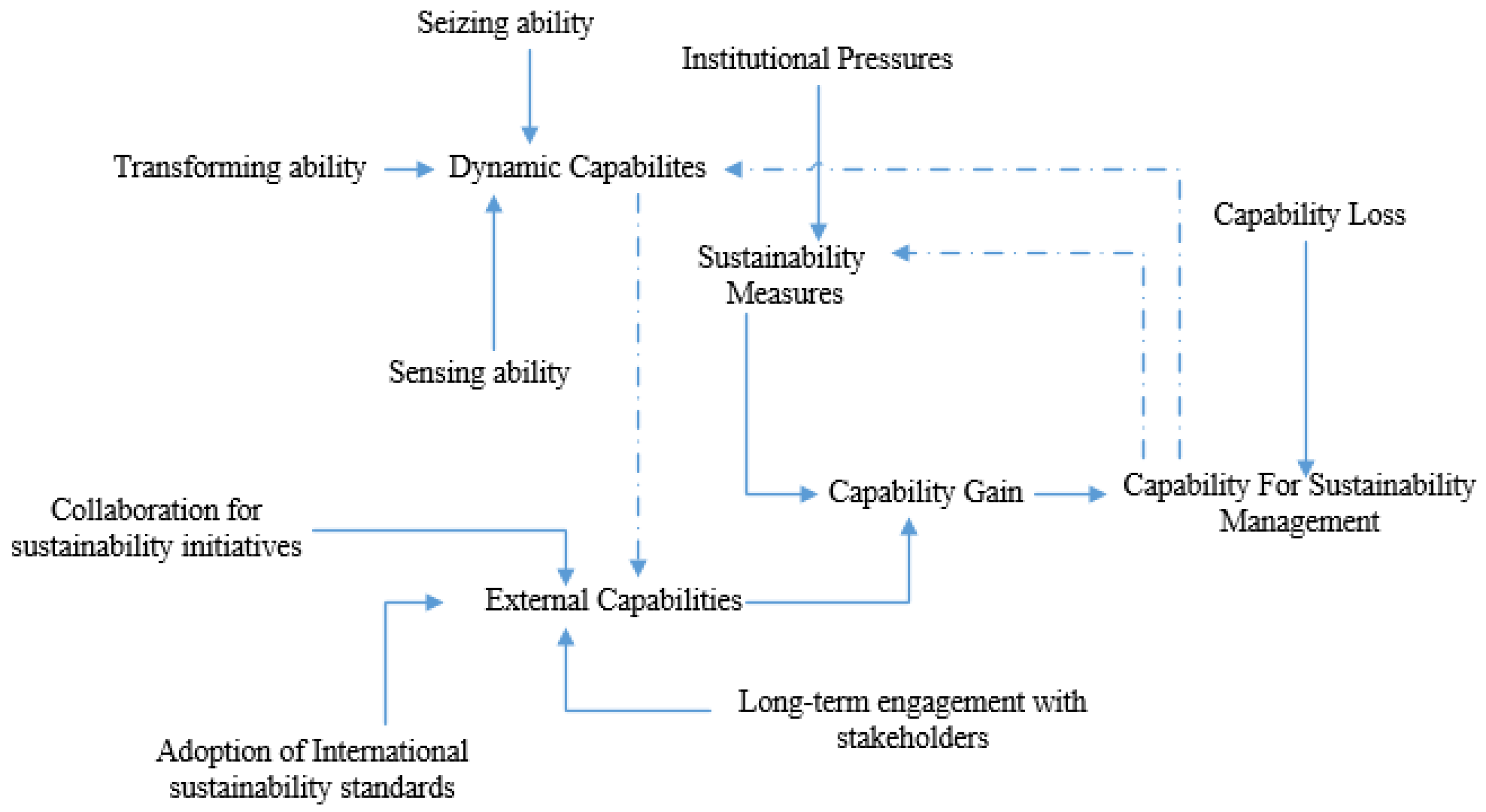
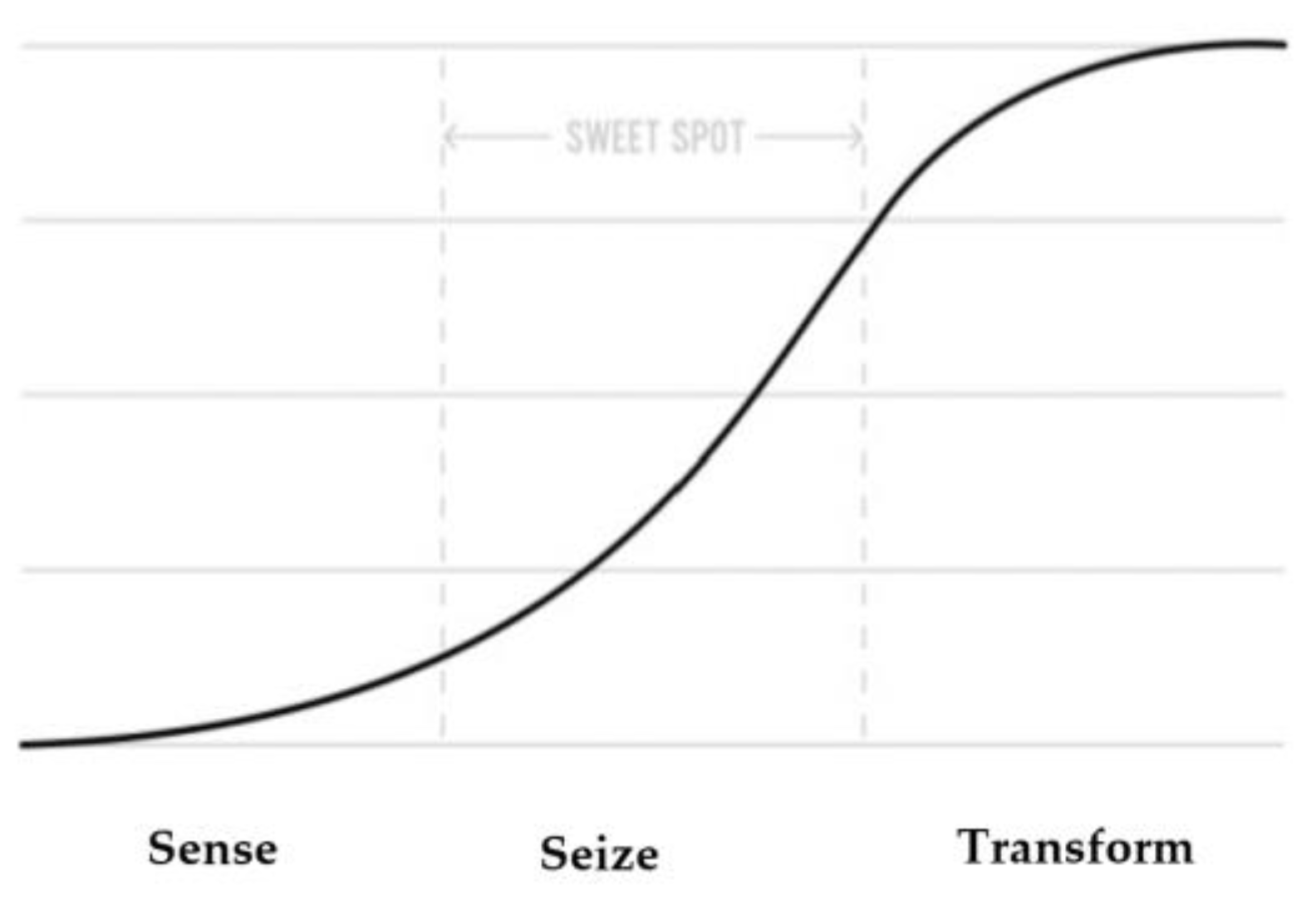
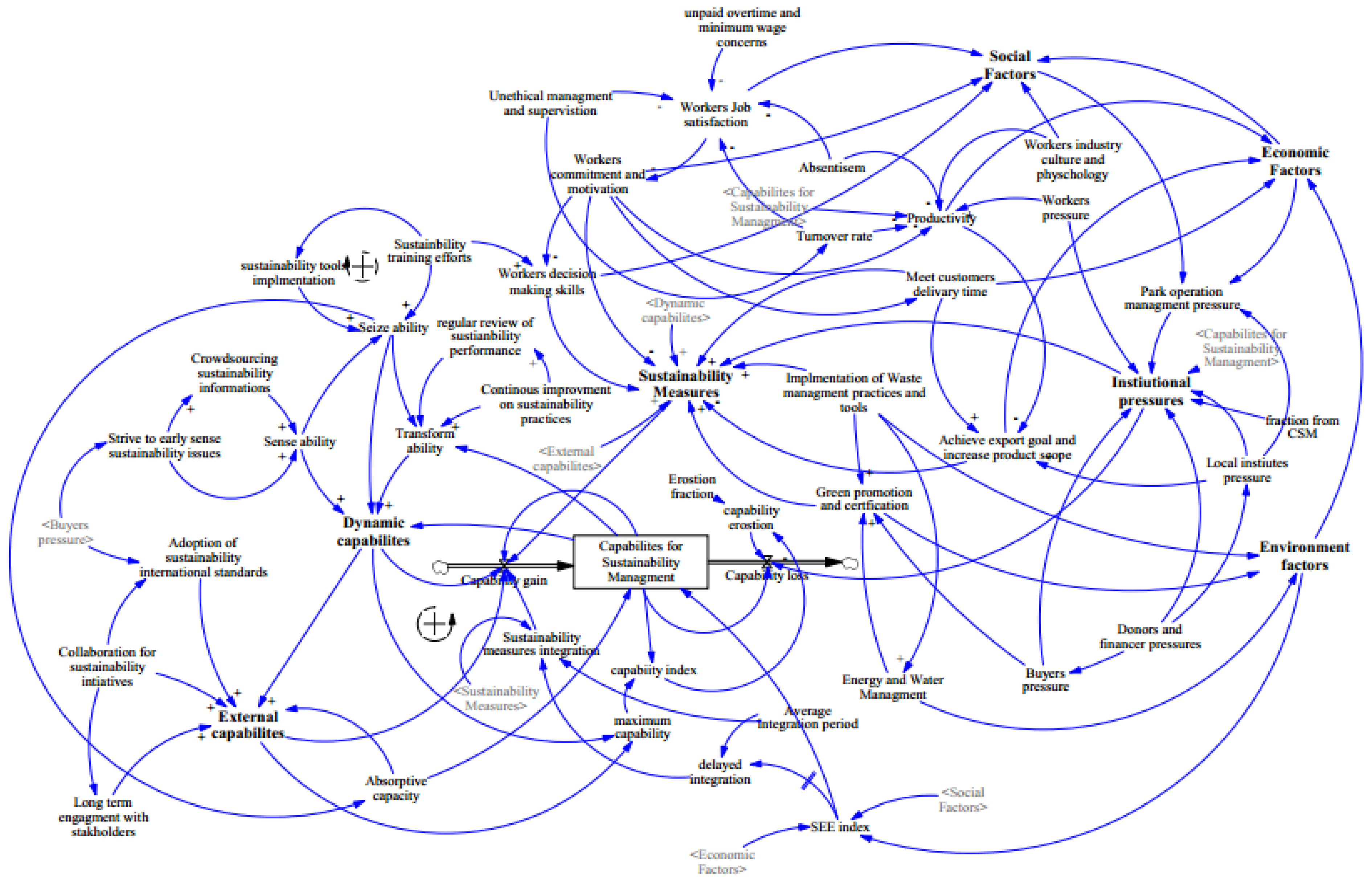


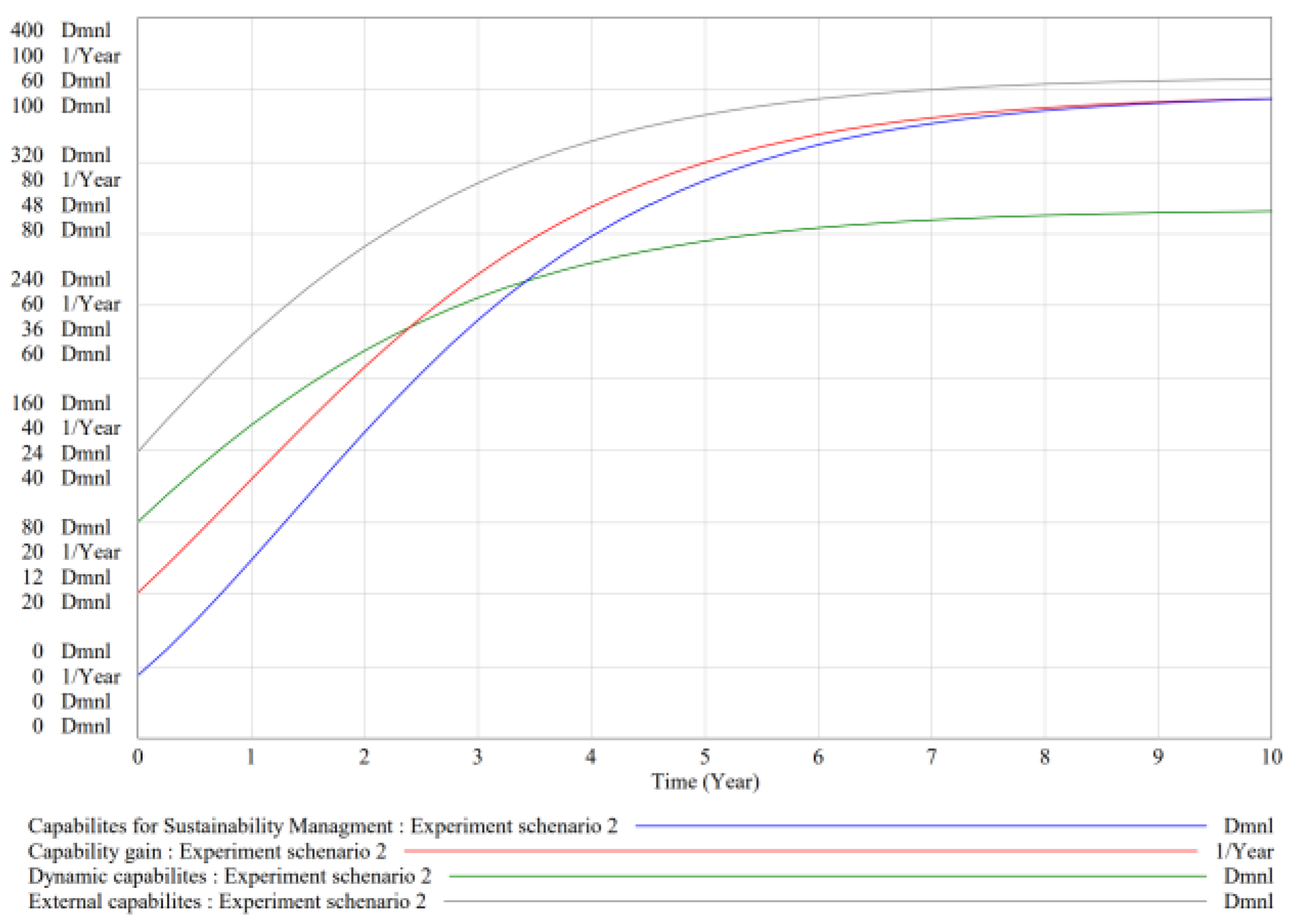

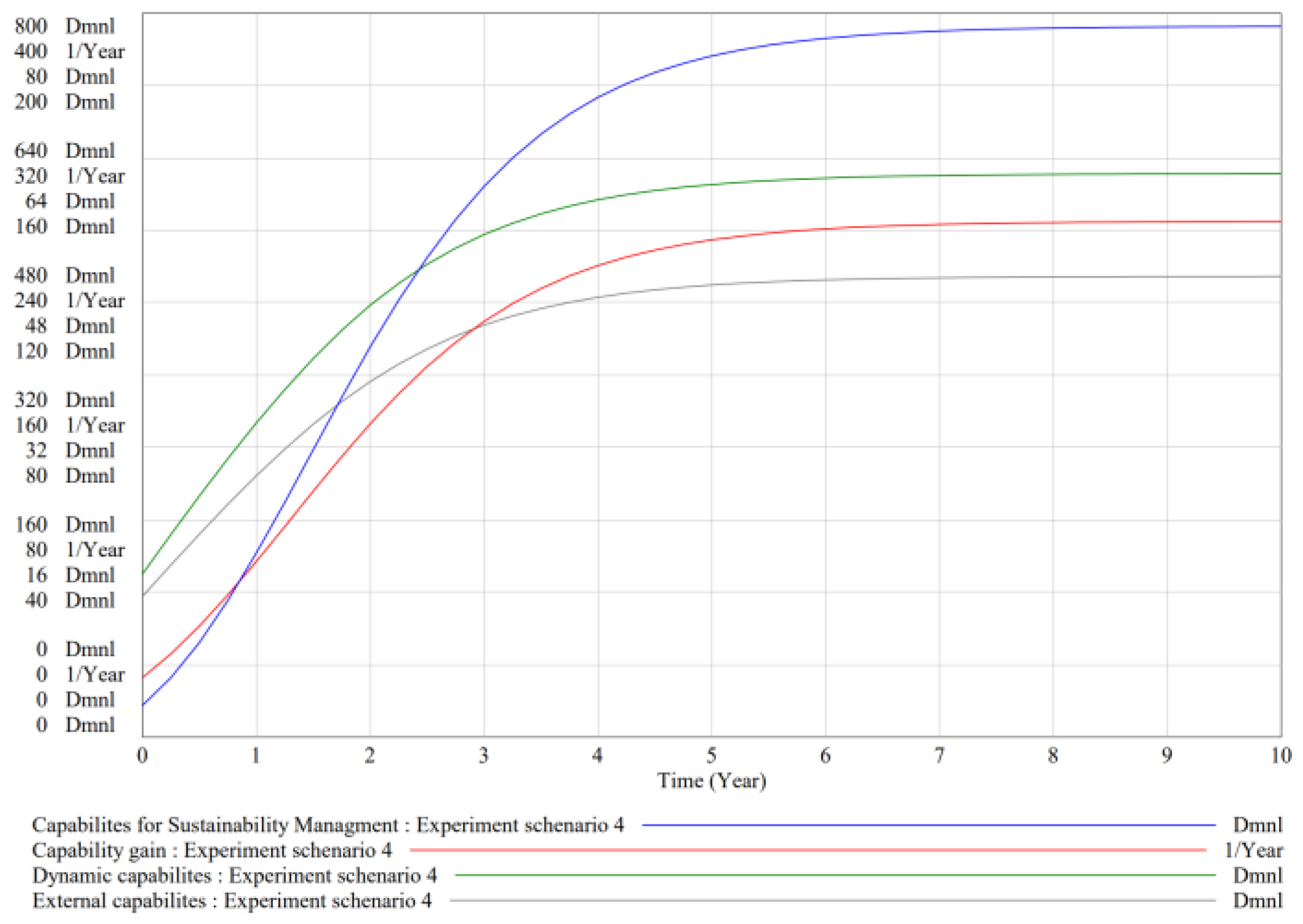
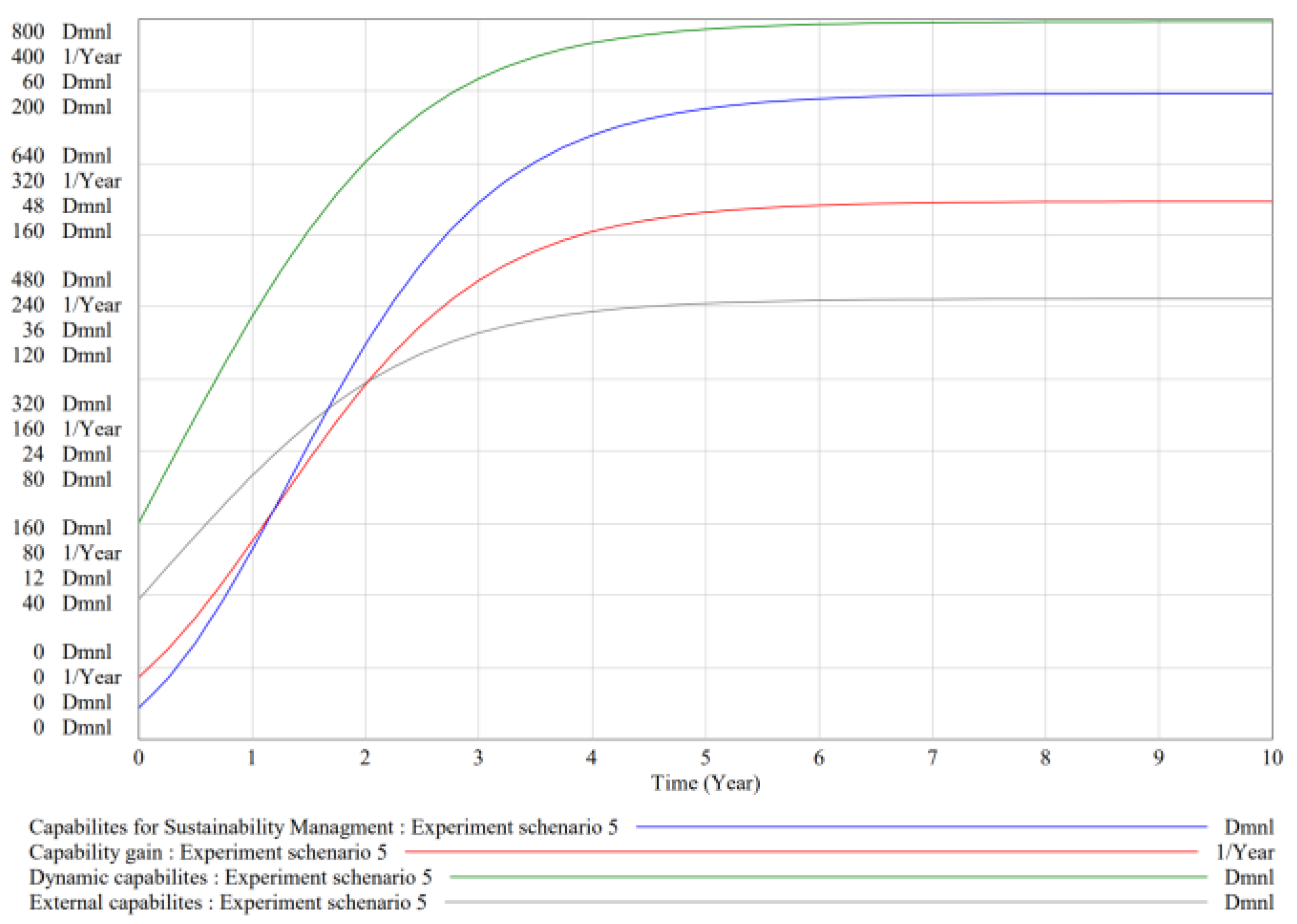
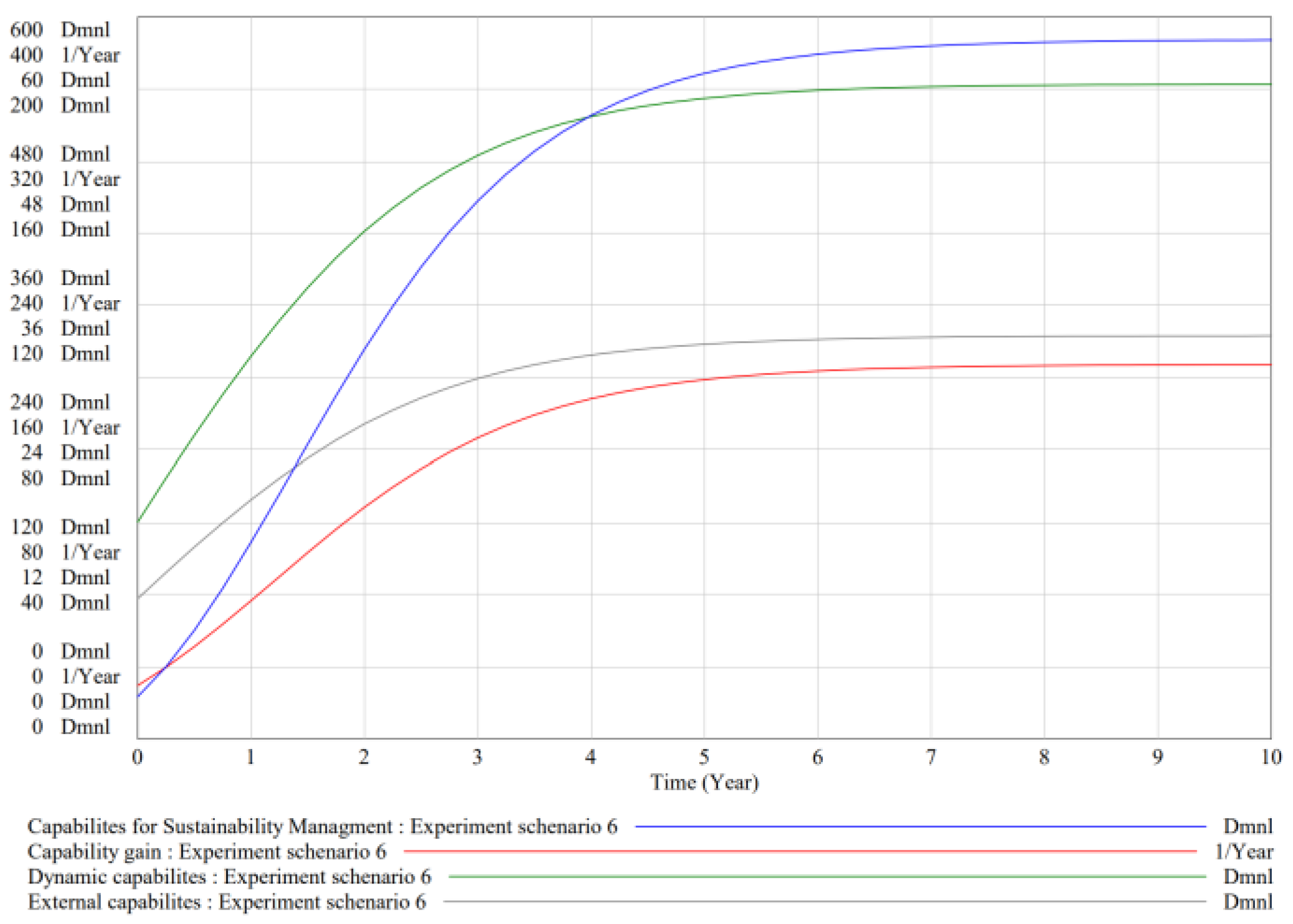



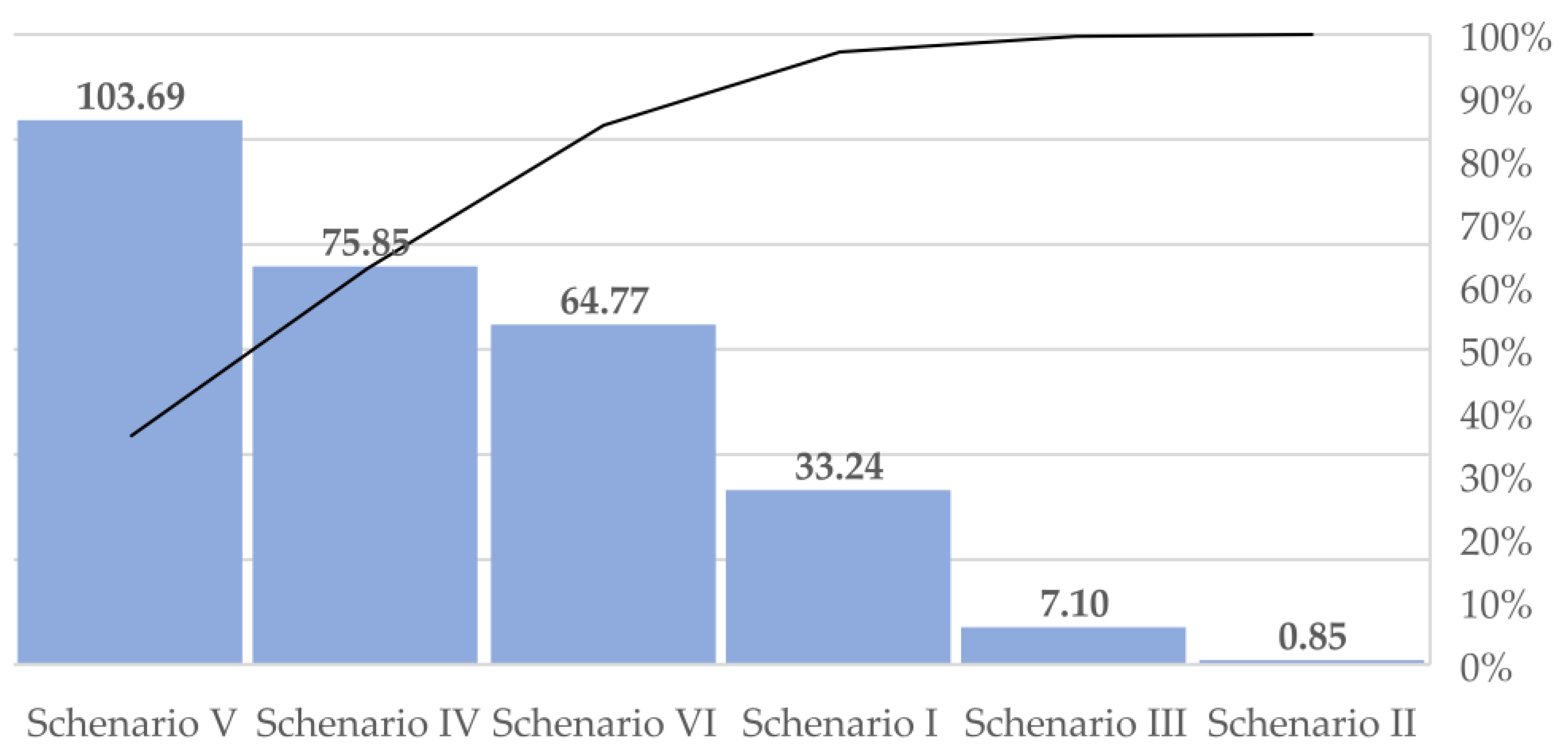

| Dimensions | Variables | Sub-Variables | Sources |
|---|---|---|---|
| Economical Sustainability | Financial | Profit, export performance | [30,112,113] |
| Competitiveness advantage | |||
| Operational | Order delivery performance | ||
| Product quality | |||
| Productivity | |||
| Social Sustainability | Health and safety | Working accidents, illness | [114,115,116] |
| Safety training | |||
| Labor development and work satisfaction | Commitment and motivation, Fair wage schemes, turnover | ||
| Decision-making skills | Sustainability awareness, training, and education | ||
| Decent work and ethics | Absence, culture | ||
| Environmental Sustainability | Management | Sustainable and waste reduction practices | [117,118,119,120] |
| Environmental management system, standard | |||
| Green production strategies and management | |||
| Resource utilization | Energy and water utilization practice | ||
| Environmental friendly machines and equipment’s | |||
| Dynamic Capability | Sensing sustainability capabilities | Crowdsourcing sustainability information’s | [11,82,111] |
| Strive to early sense sustainability issues | |||
| Seizing sustainability capabilities | Sustainability training efforts | ||
| Sustainability practice and tools implementation | |||
| Transforming sustainability capabilities | Regular review of sustainability performance | ||
| Continuous improvement of sustainability practices | |||
| External Capabilities | Collaboration with stakeholders for sustainability initiatives | [121,122] | |
| Long term engagement with stakeholders | |||
| Sustainability international standards and certifications |
| Variables | Description | Average Experts Rate (0 to 1) |
|---|---|---|
| Sustainability training | Existing training delivered by most firms focuses on the worker’s technical and soft skills. Training on social and sustainability management issues is in its infancy. | 0.35 |
| Ethical management and supervision | Expat and few local experts do management and supervision. There are concerns about manager’s unethical behavior, including shouting and insulting workers. | 0.60 |
| Productivity influencing factors | Productivity of the firms is being affected highly by worker’s frequent absence from work, limited industry culture, wage concerns. In addition, workers put pressure by raising their concerns on wages housing transportation, and several strikes have been made. The minimum wage has not been set at the country level, and firms are paid the lowest wage compared to the leading apparel manufacturers, e.g., Bangladesh | Absent (0.08) |
| Industry culture (0.4) | ||
| Workers pressure (0.3) | ||
| Wage concern (0.45) | ||
| Implementation of waste management practices and tools | Industrial parks have relatively better infrastructure to handle waste. However, pro-active management practices and standards are still lacking. | 0.55 |
| Donors and financers pressure | Donors and financers have influenced firms to adopt sustainability measures, practices, and standards. | 0.65 |
| Continuous improvement on sustainability practices | Implementation of sustainability practices and developing continuous improvement strategies focusing on sustainability practices are minimal. | 0.45 |
| Collaboration for sustainability initiatives | Collaboration with buyers suppliers on sustainability management initiatives is growing in adopting international standards. However, more efforts are required from stakeholders. | 0.52 |
| Altered Variables | Base Value | Seizing Capability | Social Factors | Environment Factor | External Capability | |||||
|---|---|---|---|---|---|---|---|---|---|---|
| S1 | SF1 | SF2 | SF3 | SF4 | SF5 | WM | CS | |||
| Seizing Capability | Sustainability training effort (S1) | 0.35 | 0.60 | 0.40 | 0.45 | 0.08 | 0.40 | 0.3 | 0.55 | 0.52 |
| Social factors | Unethical management and supervision | 0.40 | 0.35 | 0.25 | 0.45 | 0.08 | 0.40 | 0.3 | 0.55 | 0.52 |
| (SF1) | ||||||||||
| Overtime and minimum wage concerns | 0.45 | 0.35 | 0.40 | 0.25 | 0.08 | 0.40 | 0.3 | 0.55 | 0.52 | |
| (SF2) | ||||||||||
| Workers industry culture and psychology | 0.40 | 0.35 | 0.40 | 0.45 | 0.08 | 0.7 | 0.3 | 0.55 | 0.52 | |
| (SF3) | ||||||||||
| Environmental Factors | Implementation of waste management practices | 0.55 | 0.35 | 0.40 | 0.45 | 0.08 | 0.7 | 0.3 | 0.65 | 0.52 |
| (WM) | ||||||||||
| External capability | Collaboration for sustainability | 0.55 | 0.35 | 0.40 | 0.45 | 0.08 | 0.7 | 0.3 | 0.55 | 0.7 |
| (CS) | ||||||||||
Publisher’s Note: MDPI stays neutral with regard to jurisdictional claims in published maps and institutional affiliations. |
© 2022 by the authors. Licensee MDPI, Basel, Switzerland. This article is an open access article distributed under the terms and conditions of the Creative Commons Attribution (CC BY) license (https://creativecommons.org/licenses/by/4.0/).
Share and Cite
Bayu, F.; Berhan, E.; Ebinger, F. A System Dynamics Model for Dynamic Capability Driven Sustainability Management. J. Open Innov. Technol. Mark. Complex. 2022, 8, 56. https://doi.org/10.3390/joitmc8010056
Bayu F, Berhan E, Ebinger F. A System Dynamics Model for Dynamic Capability Driven Sustainability Management. Journal of Open Innovation: Technology, Market, and Complexity. 2022; 8(1):56. https://doi.org/10.3390/joitmc8010056
Chicago/Turabian StyleBayu, Fitsum, Eshetie Berhan, and Frank Ebinger. 2022. "A System Dynamics Model for Dynamic Capability Driven Sustainability Management" Journal of Open Innovation: Technology, Market, and Complexity 8, no. 1: 56. https://doi.org/10.3390/joitmc8010056




